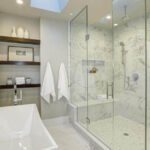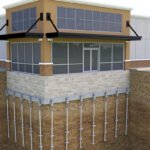Alternatives to Hardie Board: Top Siding Options Explored

When it comes to choosing siding for your home, Hardie Board, or fiber cement siding, has been a popular choice for its durability and aesthetic appeal. However, it's not the only option out there. Homeowners today have a plethora of alternatives to Hardie Board to consider, each with its unique benefits and drawbacks. In this comprehensive guide, we'll explore the top siding options available, helping you make an informed decision for your home's exterior.
- Vinyl Siding: A Cost-Effective Alternative
- Wood Siding: Timeless and Traditional
- Engineered Wood Siding: The Modern Twist
- Metal Siding: Durable and Low Maintenance
- Stucco: A Touch of Texture
- Brick Veneer: Classic Elegance
- Stone Veneer: Rustic Charm
- Natural Stone Siding: Luxurious and Lasting
- Composite Siding: The Best of Both Worlds
- PVC Siding: Lightweight and Versatile
- EIFS: Energy Efficient and Stylish
- Cedar Shake Siding: Naturally Beautiful
- Board and Batten Siding: A Vertical Delight
- Log Siding: Bringing the Outdoors In
- Fiberboard Siding: Economical and Functional
- Glass Siding: Modern and Sleek
Vinyl Siding: A Cost-Effective Alternative
Vinyl siding is one of the most popular alternatives to Hardie Board due to its cost-effectiveness and low maintenance. Made from PVC plastic, it doesn't rot, corrode, or require painting. While some criticize its appearance as less natural than other materials, modern advancements have significantly improved its aesthetic, offering a wide range of colors and textures that mimic wood and other materials. Its lightweight nature also makes installation easier and less expensive, appealing to homeowners looking for an affordable, durable siding option.
Wood Siding: Timeless and Traditional
For those seeking a classic look, wood siding offers timeless beauty and traditional charm. Whether it's cedar, pine, or redwood, wood siding provides a natural, warm aesthetic that's hard to replicate. However, it requires more maintenance than alternatives to Hardie Board, including regular painting or staining to protect against moisture, insects, and decay. Despite the upkeep, many homeowners find the natural beauty of wood siding worth the effort, making it a cherished option for those willing to invest in its maintenance.
Engineered Wood Siding: The Modern Twist
Engineered wood siding is a modern take on traditional wood siding, offering the look and feel of real wood with less maintenance. Made from wood fibers and resins, it's designed to resist moisture, rot, and insects more effectively than natural wood. This makes it a compelling alternative to Hardie Board for homeowners who love the appearance of wood but want to avoid the upkeep. Engineered wood siding is also more environmentally friendly than some options, as it often uses recycled materials and less wood overall.
Metal Siding: Durable and Low Maintenance
Metal siding, including aluminum and steel, stands out among alternatives to Hardie Board for its durability and low maintenance. It's resistant to fire, rot, and pests, and it can last for decades with minimal upkeep. Metal siding also offers a modern aesthetic, with a variety of finishes and colors to choose from. While it can be more expensive upfront, its longevity and resistance to damage make it a cost-effective option in the long run. However, it can dent and may not be suitable for areas prone to severe weather.
Stucco: A Touch of Texture
Stucco siding offers a unique texture and appearance, making it a popular alternative to Hardie Board in regions with Mediterranean or Spanish architectural styles. Applied in layers over a wire or wood lath, stucco creates a durable, seamless exterior that's resistant to fire and pests. It also provides excellent insulation, helping to keep homes cooler in the summer and warmer in the winter. While stucco can be more labor-intensive to install, its distinctive look and energy efficiency benefits make it a favored choice for many homeowners.
Brick Veneer: Classic Elegance
Brick veneer offers the classic elegance of traditional brick construction without the need for structural brick walls. As an alternative to Hardie Board, brick veneer is installed as an outer layer over the home's structure, providing the aesthetic of brick with added insulation benefits. It's highly durable, fire-resistant, and requires little maintenance, making it a timeless choice for homeowners. However, the installation can be costly and time-consuming, which is something to consider when comparing options.
Stone Veneer: Rustic Charm
Stone veneer siding adds rustic charm and a touch of luxury to any home. As an alternative to Hardie Board, it mimics the look of natural stone at a fraction of the cost and weight, making it easier to install on a variety of structures. Stone veneer is available in numerous styles and colors, allowing homeowners to customize their exterior to match their personal taste. While it's durable and low maintenance, proper installation is crucial to prevent moisture issues, making it important to work with experienced contractors.
Natural Stone Siding: Luxurious and Lasting
For those seeking the pinnacle of luxury and durability, natural stone siding is unmatched. Unlike other alternatives to Hardie Board, natural stone offers a unique, timeless appearance with each piece being distinct. It's incredibly durable, resistant to fire, weather, and pests, and requires minimal maintenance. However, its weight and the complexity of installation make it one of the most expensive siding options. For homeowners willing to invest, natural stone siding provides a stunning, long-lasting exterior that can significantly increase a home's value.
Composite Siding: The Best of Both Worlds
Composite siding is a versatile alternative to Hardie Board that combines the best features of various materials. Made from a mixture of wood fibers, plastics, and binders, it's designed to mimic the appearance of wood, stone, or other materials while offering superior durability and lower maintenance. Composite siding is resistant to moisture, rot, and insects, and it's available in a wide range of colors and textures. Its versatility and ease of maintenance make it an attractive option for homeowners looking for a balance between aesthetics and functionality.
PVC Siding: Lightweight and Versatile
PVC siding is another lightweight and versatile alternative to Hardie Board. Similar to vinyl siding but made from polyvinyl chloride (PVC), it offers excellent durability, resistance to moisture, and low maintenance. PVC siding is available in a variety of styles and colors, including options that closely resemble natural wood. Its lightweight nature simplifies installation, potentially reducing costs. For homeowners seeking a durable, easy-to-maintain siding option with a wide range of aesthetic choices, PVC siding is worth considering.
EIFS: Energy Efficient and Stylish
Exterior Insulation and Finish Systems (EIFS) are an innovative alternative to Hardie Board that offer both style and energy efficiency. EIFS are multi-layered exterior wall systems that provide insulation and a water-resistant finish. They're designed to mimic the appearance of stucco, stone, and other materials, allowing for creative design flexibility. EIFS improve a home's energy efficiency by reducing thermal bridging and air infiltration. While they require professional installation and maintenance to prevent moisture issues, EIFS are a popular choice for their aesthetic appeal and insulation benefits.
Cedar Shake Siding: Naturally Beautiful
Cedar shake siding is a naturally beautiful alternative to Hardie Board that adds character and warmth to any home. Made from split logs, cedar shakes offer a rustic, textured look that's particularly popular in coastal and woodland settings. Cedar is naturally resistant to rot, decay, and insects, making it a durable siding option. However, like other wood sidings, it requires regular maintenance to preserve its appearance and longevity. For homeowners drawn to its natural beauty, cedar shake siding is an appealing choice that blends durability with aesthetic appeal.
Board and Batten Siding: A Vertical Delight
Board and batten siding is a distinctive alternative to Hardie Board that features a combination of wide boards and narrow strips (battens) to create a vertical pattern. This style is often associated with farmhouse and rustic designs but can be adapted to suit a variety of architectural styles. Board and batten siding can be made from wood, vinyl, or fiber cement, offering flexibility in materials and maintenance requirements. Its unique appearance and versatility make it a popular choice for homeowners looking to add character and dimension to their home's exterior.
Log Siding: Bringing the Outdoors In
Log siding offers the look and feel of a log cabin with the convenience of traditional siding. As an alternative to Hardie Board, it's available in wood, vinyl, and engineered wood options, allowing homeowners to achieve a rustic aesthetic without the structural requirements of actual logs. Log siding adds warmth and charm to any home, creating a cozy, inviting atmosphere. While it may require more maintenance if made from natural wood, its distinctive look is highly sought after by those wishing to bring a touch of the outdoors in.
Fiberboard Siding: Economical and Functional
Fiberboard siding is an economical and functional alternative to Hardie Board that's made from recycled wood fibers, resin, and wax. It's engineered to be durable, moisture-resistant, and easy to paint, making it a practical choice for homeowners on a budget. While it doesn't offer the same level of durability as some other options, its affordability and ease of installation make it an attractive option for those looking to update their home's exterior without breaking the bank.
Glass Siding: Modern and Sleek
For a truly modern and sleek look, glass siding is an innovative alternative to Hardie Board. It offers a contemporary aesthetic that allows for natural light to permeate the home, creating a bright and airy interior. Glass siding can be used in combination with other materials to create unique, eye-catching designs. While it requires careful installation and maintenance to ensure energy efficiency and privacy, glass siding is a bold choice for homeowners looking to make a statement with their home's exterior.
While Hardie Board remains a popular siding choice for many homeowners, the market is rich with alternatives to Hardie Board that cater to a wide range of preferences, budgets, and architectural styles. From the timeless appeal of wood siding to the modern sophistication of glass, each option offers its own set of benefits and considerations. By carefully evaluating your priorities and working with experienced professionals, you can select the siding material that best suits your home's needs and enhances its curb appeal for years to come.





Leave a Reply